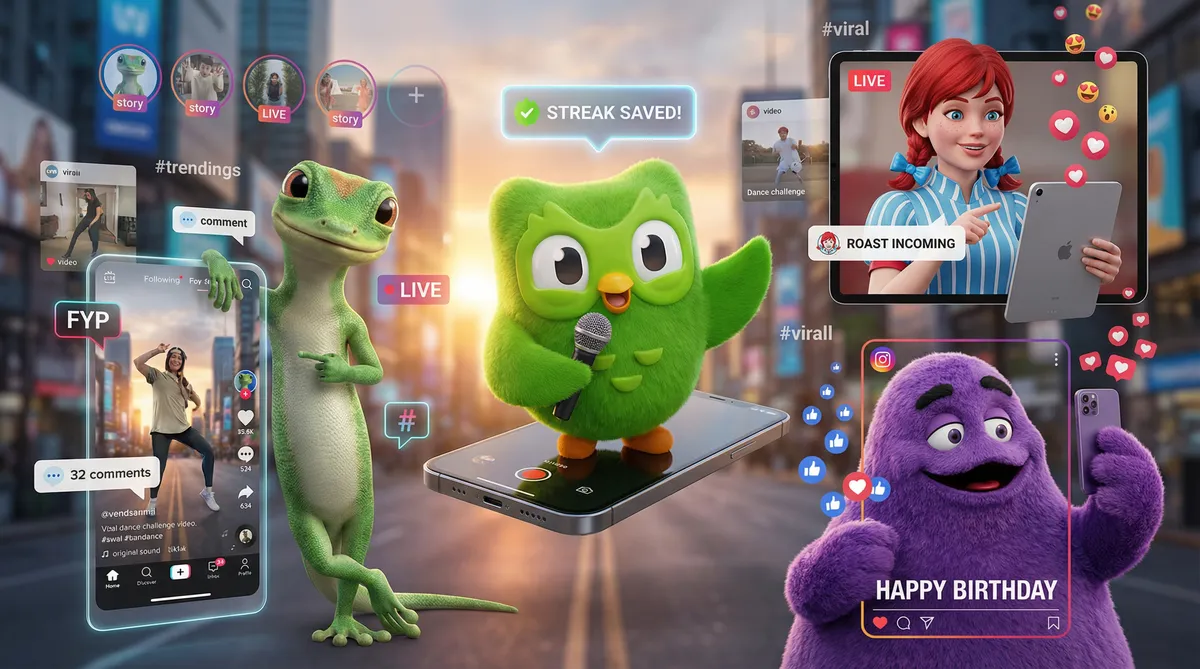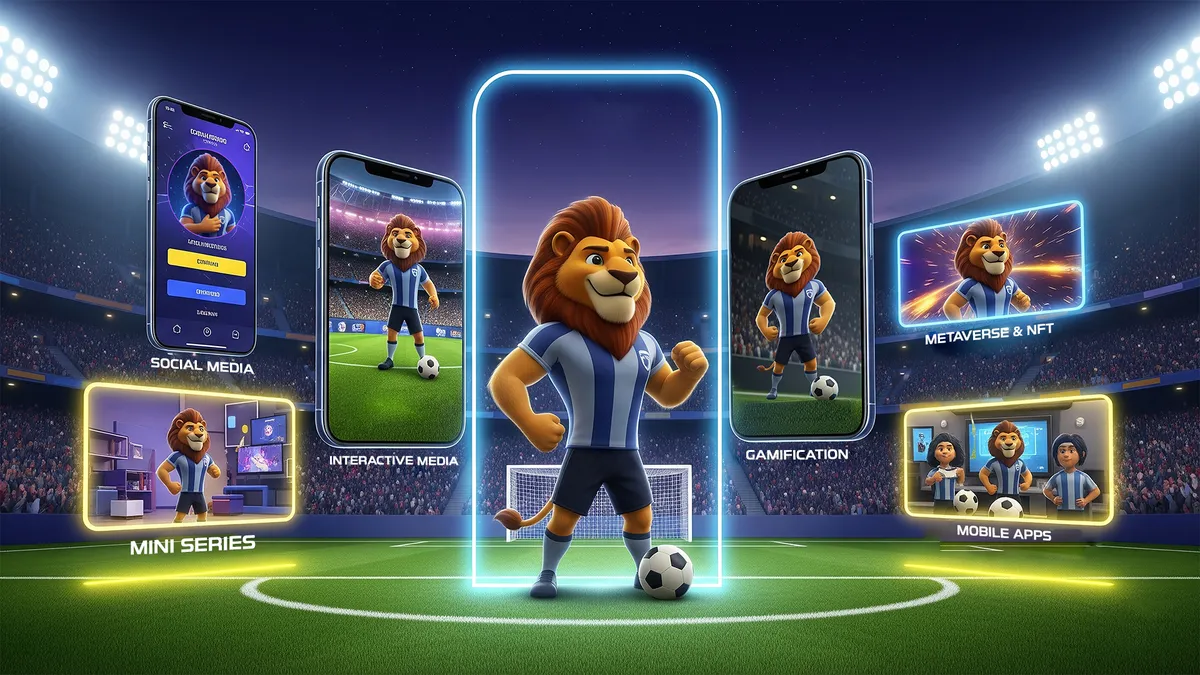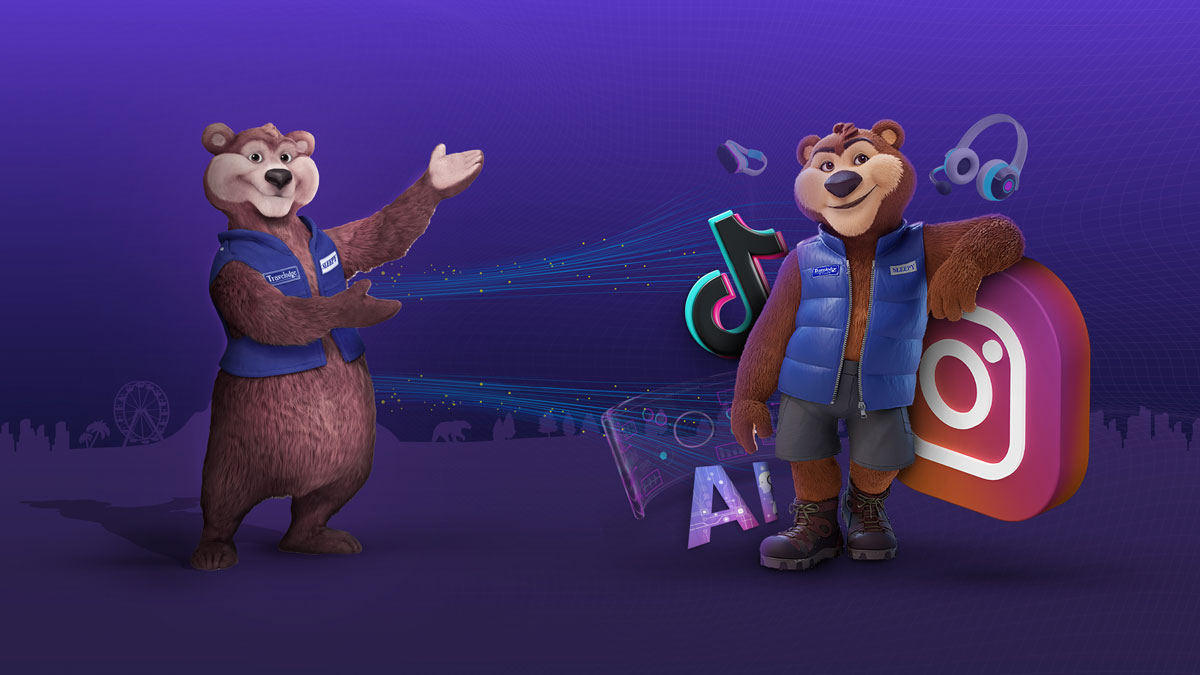
Early computers were revolutionary, but would you use one today? Of course not. The same logic can apply to a brand’s most visible representative.
To understand why, it’s essential to first know what brand mascots are. Just like old technology, characters created years ago can become outdated and less effective over time.
This brings us to a key concept we’ll explore in this blog.
Here, you’ll learn everything you need to know about updating a brand mascot.
The solution helps businesses breathe new life into their old characters and make them appealing to modern audiences and current tastes.
Let’s begin by answering a key question at the heart of this topic.
Why Would You Need to Update Your Brand’s Mascot?
Let’s be real—if your mascot looks like it stepped out of a dusty time capsule, it’s probably time for a glow-up. But hold on—this isn’t just about aesthetics. Updating your brand mascot is about future-proofing your entire identity. So, what’s the deal?
Let’s break it down.
1. Because… It’s Just Old
Sometimes the only reason you need? Age. Yep. Your mascot might’ve killed it back in the day, but if it’s giving “retro” in all the wrong ways, it’s time to rethink things. But don’t stop there—aging alone isn’t the issue. The smarter move? Use the opportunity to plug your character into new tech and fresh storytelling formats.
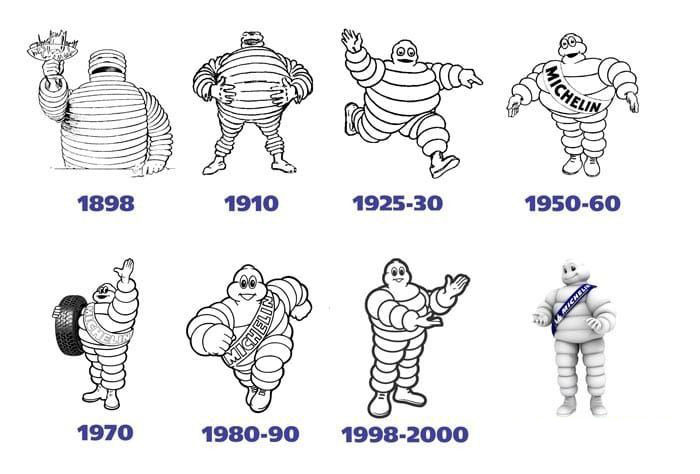
Imagine turning that flat, passive mascot into a dynamic brand rep who pops up in reels, stories, apps, and even metaverse meet-and-greets. Boom. Instant relevancy.
2. Your Brand Isn’t the Same—Why Should Your Mascot Be?
Brands evolve. Maybe your tone’s gone from stiff to snappy. Maybe your audience is younger, more global, more values-driven. Whatever the change, your mascot should evolve with you—or risk looking completely off-brand.
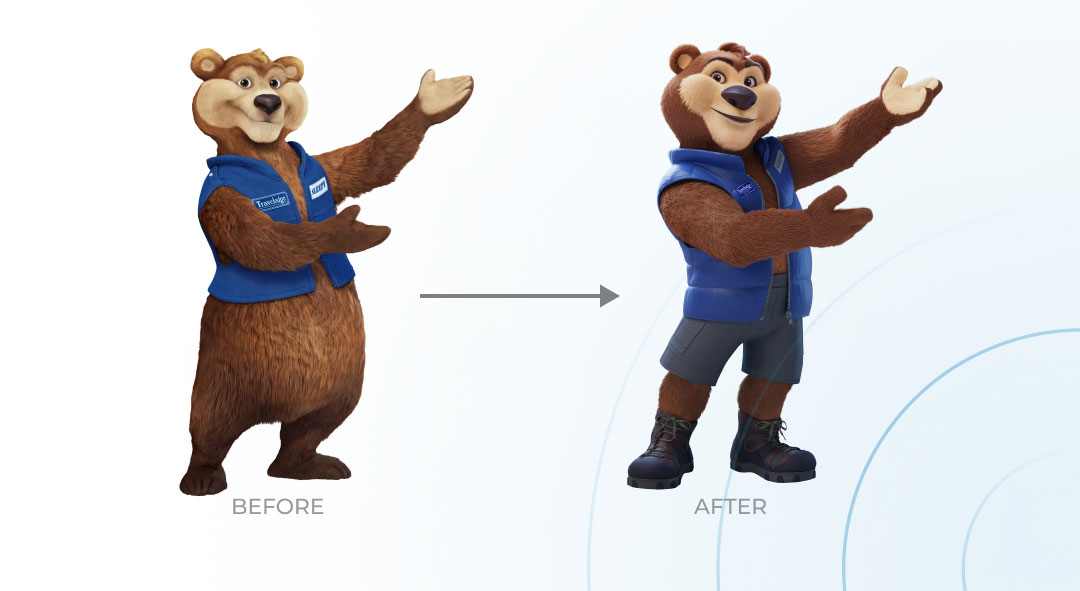
Mascots are avatars of your brand personality. If yours still talks like it’s 1997 while your brand’s rocking 2025 vibes… that’s a problem. A visual and emotional mismatch. Fix it.
3. People’s Tastes Changed—Did Your Mascot Keep Up?
Let’s face it—what looked “cool” in 2003 might now scream “graphic design is my passion.” If your mascot’s outfit, colors, or vibe doesn’t resonate anymore, no one’s paying attention. And if they are, it’s not the good kind.
New design = fresh energy. Simple.
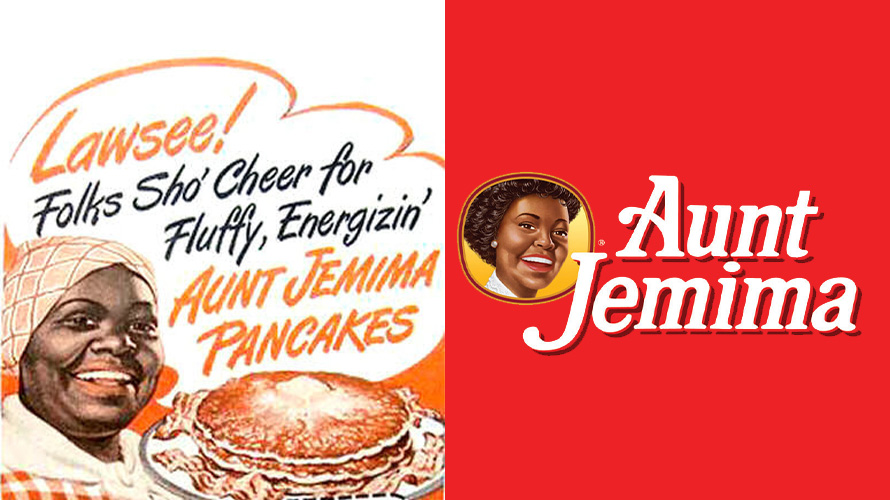
A modernized look can pull your character out of obscurity and shove them right back into the spotlight where they belong.
4. Static Characters Can’t Survive in a Moving World
Today, mascots aren’t just printed on packaging. They move. They talk. They trend. They show up in videos, animations, AR filters, interactive content, and even live chat.
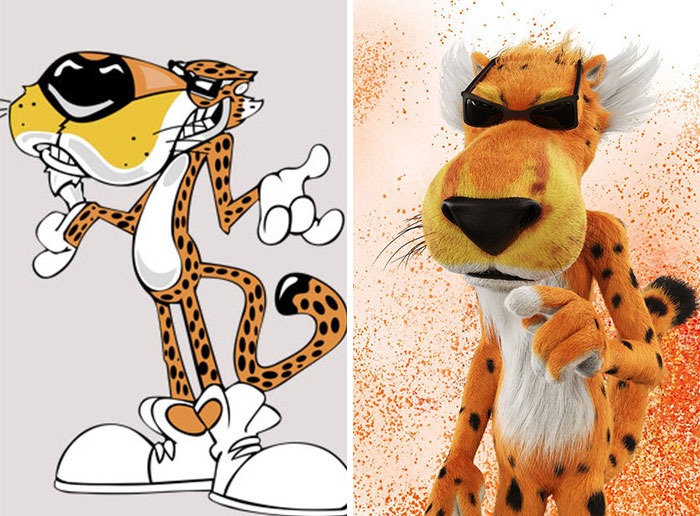
So if your current mascot is stuck in 2D, you’re missing out—big time. A proper update gives your brand the power to flex across every channel your audience touches.
5. Culture’s Changed. Your Mascot Better Be Ready.
Let’s be blunt: what passed for “funny” or “relatable” in the past might be cringey or even offensive today. A good mascot is universally likable—but a great one evolves with the times.
Ask yourself: is your mascot inclusive? Is it in tune with today’s social landscape? If the answer’s “not sure,” don’t wait for a PR nightmare to find out.
What Not to Do: Mascot Makeovers Gone Wrong
Let’s also talk red flags. Please don’t redesign your mascot just because:
- “Everyone else is doing it.”
- “I’m bored with it.”
- “I have a vibe it needs a change.”
Nope. This isn’t a haircut—it’s a brand asset. Mascot updates should be rooted in strategy, audience insights, and platform evolution. Anything less? You’re gambling with brand equity.
Next up? We’re diving into what makes today’s mascots different from the ones that came before—and how to turn your character into a full-blown digital brand ambassador.
Old vs. New Mascots: What’s the Difference?
Let’s rewind a few decades.
Back then, mascots were mostly eye candy—printed on packaging, plastered on billboards, and… that’s pretty much it. They looked cute, maybe had a catchy slogan, and that was the end of the story.
They were silent. Static. Totally one-dimensional.
Now fast-forward to today—different world, different rules.
New Virtual Mascots? Total Game-Changers.
Modern mascots aren’t just characters. They’re digital brand reps, multi-platform performers, and full-blown content creators. If your mascot still just “sits” on a label, it’s stuck in the past.
Today’s mascots move, speak, post, respond, and connect. Actually they are not a simple mascot, They’re designed from day one with a strategy in mind—how they’ll show up on TikTok, what they’ll say in your chatbot, how they’ll host product drops, and how they’ll represent your brand personality in a world that’s all about personality.
Read more about virtual influencers.
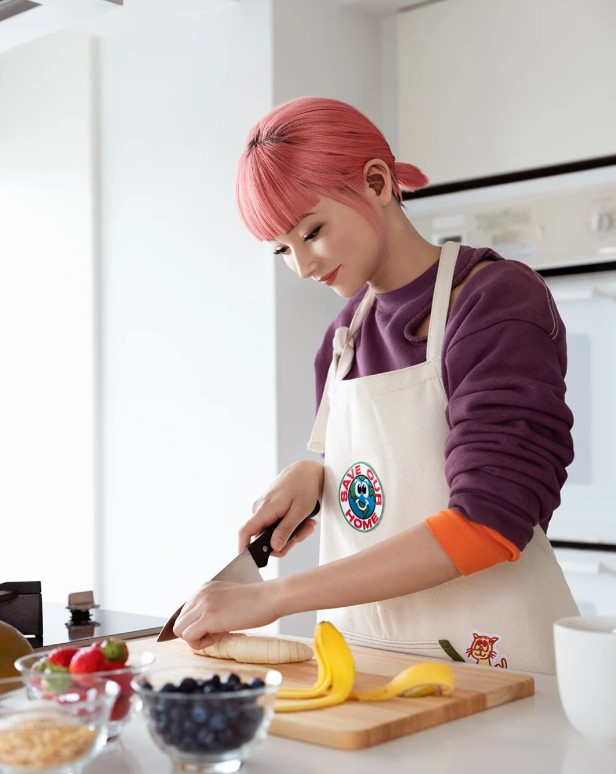
Here’s the shift: old mascots were symbols—flat images used to signal identity.
New mascots are AI-based systems. They function. They work across formats, adapt to different audiences, and can be upgraded with AI to do everything from running livestreams to acting as your 24/7 customer service rep.
Yep. They’re basically your newest hire!
They’re built to respond, listen, react, and evolve in real-time. That’s exactly what your audience expects—and it’s why modern characters outperform outdated ones, every single time.
Modern consumers want conversation, not decoration. If your mascot can’t talk back, it’s already behind.
So What’s the Move?
When you update your brand mascot, don’t just make it “look nicer.” Redesign it to do more. Give it a purpose. A voice. A plan and more functionality.
That’s what separates the classics from the forgettables.
Ready to meet the new generation of mascots? Stick with us—we’re about to show you how these modern characters are changing the entire game.
Next up: Should You Create a Whole New Mascot—Or Just Update the Old One?
Let’s settle that question from experts in brand mascot design.
Create a New Mascot From Scratch or Update the Old Character?
This is the big question. And spoiler: slapping a new outfit on your old mascot doesn’t always cut it.
Sometimes, your existing character is so outdated, irrelevant, or just plain cringe, that there’s only one move left: a full-on reboot.
So… how do you know when to update and when to toss it all and start fresh?
Let’s break it down.
When It’s Time to Say Goodbye:
1. Your Brand Has Evolved—Massively
You’re not the same brand you were a decade ago. Maybe you started out as a car repair shop and now you’re selling premium houseplants. If your old mascot was a greasy mechanic, and your new customer is a plant-loving minimalist with an eye for aesthetics… yeah, it’s not a match.
New industry? New values? New audience?
That’s your cue to build a new mascot from the ground up.
2. No Detail, No Depth, No Chance
Back in the day, mascots were slapped on cereal boxes and called it a day. Detail? Who cared?
But now? Your mascot is showing up in 4K videos, hosting livestreams, maybe even starring in VR experiences.
If your legacy character is so flat and featureless that you can’t even upgrade it without guessing what its personality is supposed to be… that’s not an update. That’s dead weight. Let it go.
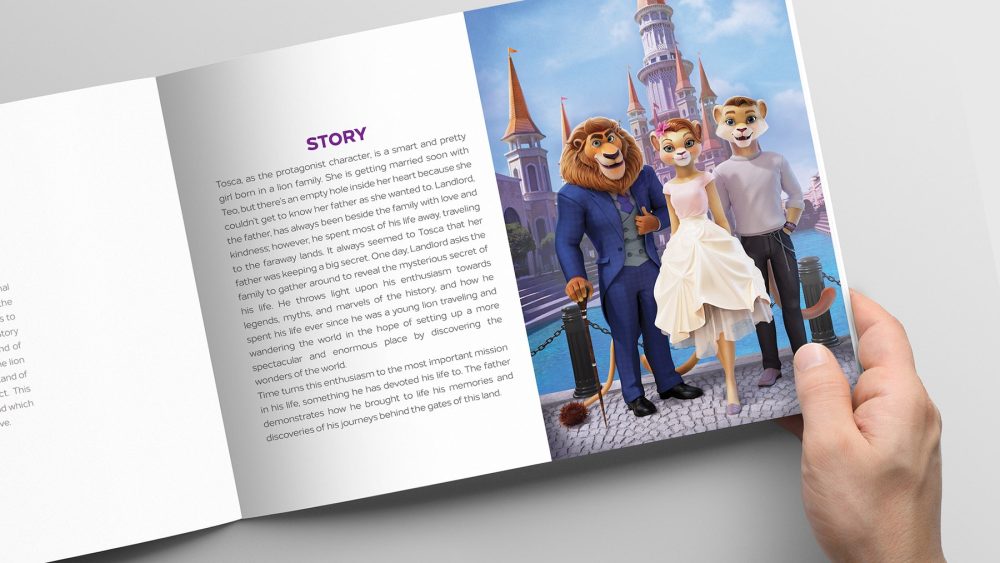
3. It’s Culturally Problematic (Yep, We Said It)
Let’s be honest: some mascots aged badly. Maybe they were fine in the ’80s, but today? Yikes.
If your old character could trigger backlash—or already has—you don’t “tweak” that. You bury it. Start fresh. Clean break. No apologies needed when you lead with a new, inclusive, future-facing brand identity.
Bonus: this also applies when legal regulations change. If your mascot breaks the rules in 2025, you can’t Photoshop that away.
4. Gen Z Thinks It’s Ugly
This may sound shallow, but design matters. If your old mascot looks like clipart and today’s audience is all about sleek, edgy, or hyper-cute? They’re not buying it. (Literally.)
No one connects with something they wouldn’t even bother to screenshot.
TL;DR:
- Update if the bones are strong.
- Start fresh if there’s nothing worth saving.
You’re not just changing a face—you’re deciding who will represent your brand in the spotlight across every platform. Make that decision with intention.
How to Update a Brand Mascot
So you’ve decided your mascot needs a makeover—not a funeral. Smart move. But before you whip out the digital paintbrush, let’s make sure you’re doing this right.
Updating a mascot isn’t just “cleaning up the lines” or throwing on a trendy outfit. It’s a strategic redesign. Think of it less like changing clothes—and more like sculpting a new identity from the DNA of your brand.
Ready? Let’s walk through it.
Step 1: Know Thy Brand (Like, Really Know It)
Before you touch a pixel, pause. Your mascot isn’t just a visual—it’s a walking, talking embodiment of your brand’s soul.
This first step? Absolute non-negotiable.
Start with questions like:
- Who’s our ideal customer now (not 5 years ago)?
- What are our mission, vision, and core values?
- What’s our personality—playful, bold, brainy, chill?
- What makes us different from the competition?
The more clearly you define this, the better your updated mascot can personify your brand’s actual identity—not some vague marketing fluff.
Shortcut fail alert: Skipping this step = creating a mascot that looks cool but says nothing. Don’t build a character your audience scrolls past.
Solid brand clarity = strong mascot foundation. Period.
Step 2: Lock In the Right Archetype (a.k.a. Your Mascot’s Core Personality)
Alright, you’ve nailed the brand’s identity. Now it’s time to channel all that insight into your mascot’s archetype—their emotional DNA.
This is where your mascot goes from “just a drawing” to “a character people remember.”
Are they…
- The Hero — bold, driven, built to inspire action?
- The Jester — fun, cheeky, always vibing with Gen Z?
- The Sage — wise, trustworthy, ready to drop knowledge?
- The Caregiver — empathetic, loyal, community-focused?
You get the idea.
This step is all about choosing the narrative your character lives and breathes. Because let’s be honest—if your brand is all about innovation and your mascot feels like your quirky uncle from 2007… you’ve got a brand mismatch.
Pro tip: The archetype you choose should align with both your brand and your audience’s expectations. It’s about resonance, not random vibes.
Not sure which archetype fits?
Coming up next: defining exactly what your mascot does—because today’s characters need jobs, not just good looks.
Step 3: Build the World & Flesh Out the Personality
Here’s where things get juicy. Your mascot isn’t just a face—it’s a character. A real one (well, virtually speaking).
And what does every memorable character have?
A backstory. A vibe. A whole universe they come from.
Why this matters:
The more depth you give your mascot, the more usable and relatable it becomes. It’s not just “cute branding”—it’s a storytelling engine that can power your content, campaigns, and even entire experiences.
Start with the world:
Where did your mascot come from? What’s their journey?
Are they a tech whiz from the metaverse? A nature guardian from an enchanted forest? An AI robot learning how to connect with humans?
Create an origin story that aligns with your brand’s core values and gets people intrigued.
Then: build the personality profile
Time to answer the juicy stuff:
- Are they witty and sarcastic—or thoughtful and sincere?
- Do they talk a mile a minute—or slow and steady with authority?
- Are they young, rebellious, and energetic—or older, wiser, and grounded?
- What human traits define them—curiosity? Empathy? Nerdy genius?
This isn’t fluff. It’s brand strategy wrapped in narrative. These details will shape how your mascot talks, reacts, and shows up across channels.
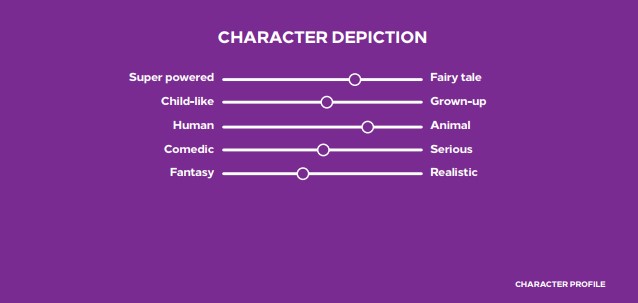
One big warning: Don’t wing it.
Random answers = random mascot = confused audience.
Every choice should be grounded in your brand’s identity and your audience’s expectations.
Step 4: Lock In the Mascot’s Tone of Voice
Time to give your mascot a voice that actually feels like them.
By now, you’ve got their personality nailed. You know who they are, where they come from, and what they stand for. So in this phase, you’re zeroing in on how they talk, react, and connect.
This is where you turn vibes into verbal identity.
It’s More Than Just Words
Don’t confuse “tone of voice” with just vocabulary. This is about:
- Emotion: Are they warm? Excited? Snarky?
- Energy level: Chill and mellow, or loud and high-octane?
- Formality: Casual, slang-savvy—or buttoned-up and polished?
- Delivery style: Quick, punchy quips? Or thoughtful, extended advice?
- Behavioral traits: Do they comfort? Challenge? Entertain?
And most importantly: Does it match the archetype and profile you already built?
If you crafted your mascot to be a bold, meme-savvy rebel…
But gave them a tone like a corporate finance advisor?
Yeah, your audience is going to bounce.
Think of this stage as an inverted funnel.
All the wide creative exploration you did earlier? Now it sharpens. This is where your decisions become final. Precise. On-brand.
Once your mascot has a distinct voice, they’re ready to speak across campaigns, captions, customer support scripts—even voiceovers or AI integrations.
Step 5: Develop the Mascot’s New Look
Time for the fun (and incredibly important) part: visuals.
Whether you’re making a few cosmetic tweaks or doing a full redesign from scratch, your mascot’s new look will set the tone before it ever says a word. Because let’s face it—first impressions aren’t made through tone of voice or clever bios. They’re made in milliseconds through visuals.
So here’s how to make them count.
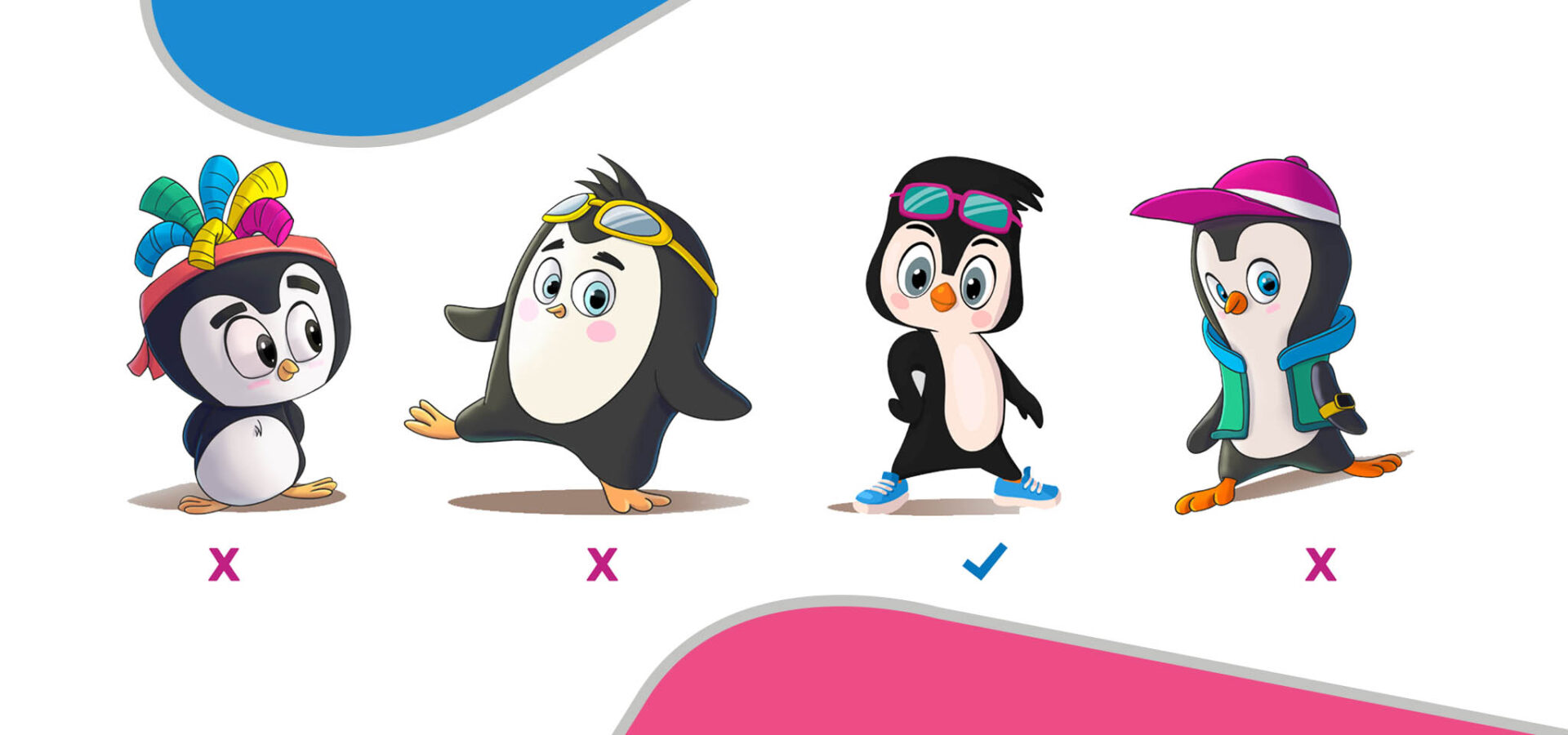
Start With Strategy, Not Style
Before your design team starts sketching, huddle up and revisit what you’ve already decided:
- What archetype did you choose?
- What emotions does the tone of voice carry?
- Where does your mascot live—what kind of universe are they from?
- Is this character bold, quirky, elegant, tough, or soft?
Answering these gives you creative constraints—and that’s a good thing. When you know your mascot is an energetic teen from a futuristic city who speaks in memes, that rules out 90% of design noise and gets you closer to a clear, consistent look.
Small Refresh or Full Reboot?
- If you’re updating a mascot: maybe you just need sharper lines, modern colors, a wardrobe glow-up, or more expressive features.
- If you’re starting fresh: then yeah—it’s full character development mode. That means facial structure, body shape, proportions, expressions, outfits, props… all aligned with the new persona you’ve defined.
Reminder: This isn’t about what “looks cool.” It’s about what communicates instantly and clearly.
Design for Omnichannel Use
A modern mascot has to live everywhere:
Instagram stories. YouTube ads. Packaging. Website banners. Print. Merch. Maybe even VR or AR activations.
So your new mascot design must be scalable, adaptable, and cross-platform ready.
Think vector-based for versatility. Think 3D if you’re going interactive. Think expressive and modular—so you can animate different moods, poses, and scenarios without redoing the entire thing.
Bottom line?
Looks matter—a lot. But strategy matters more. When you blend both, you don’t just get a “cool mascot.” You get a full-blown brand asset that works overtime across every touchpoint.
Step 6: Power Up Your Mascot With Tech
Let’s be real—this isn’t 1995. Your mascot can’t just exist. It needs to do.
Welcome to the era of smart mascots—powered by AI, built for engagement, and ready to serve as your brand’s digital MVP.
The Shift: From Static Icon to Virtual Influencer
Today’s best mascots don’t just stand there and look pretty. They interact. They talk. They post. They solve problems.
Translation: They’re not just symbols—they’re systems.
And one of the smartest moves you can make during an update?
Bake AI right into the redesign.
That means giving your mascot the power to:
- Act as a 24/7 chatbot or brand rep
- Answer FAQs in real-time
- Star in personalized content
- Show up in videos, livestreams, or interactive campaigns
- Learn and evolve with customer feedback
Sounds futuristic? It’s already happening
Big brands? Already on it.
Small businesses? Catching up fast.
Need proof? Check out our full breakdown in [AI Influencer]—it’s a deep dive into how AI + virtual mascots = next-gen marketing.
Don’t Skip This Step—Or Risk Falling Behind
Look, updating your mascot’s look and tone is great. But if you ignore what tech makes possible today? You’re basically installing a Ferrari engine… and leaving it in park.
This is your chance to signal that your brand gets it. You’re future-ready. You’re not stuck in mascot nostalgia—you’re building a character who’s ready to work.
Think: ML, NLP, and AI engines that let your mascot talk, listen, and connect like never before.
If you’re not thinking about how your mascot functions across automation, AI, and digital ecosystems—you’re missing the whole point of a modern update.
Now that you’ve reimagined your mascot and leveled it up with tech, one final mission remains: Let the world know.
How to Unveil the New Mascot
Updating your mascot? Awesome.
Botching the launch? Not so awesome.
Truth bomb: even the most epic mascot redesign can fall flat if your rollout is weak. We’ve seen it—brands pour months into revamping their character… only to drop it with a quiet social post and zero buzz.
Let’s not do that.
Launching your mascot should feel like a moment. A show. A story. A thing people talk about.
Here’s how to pull it off right—with a three-phase strategy that builds excitement, drives engagement, and keeps your brand in the spotlight long after the debut.
Phase 1: Pre-Launch = The Tease
This phase is pure anticipation-building. And no, we’re not saying you need to whip up hysteria—but you do want curiosity.
Think of it as the trailer before the movie.
What to do:
- Drop subtle clues — silhouettes, emojis, behind-the-scenes shots, partial reveals.
- Create countdowns — “Mascot 2.0 lands in 7 days…”
- Engage your audience — run polls (“What color do you think the new outfit is?”), quizzes, or mascot memory threads.
- Collect feedback — soft-testing design elements or sneak peeks can help course-correct before the big day.
This phase is all about controlled mystery. Build a buzz without blowing the surprise.
Phase 2: Launch = The Reveal
This is it. The spotlight’s on. Go big—or risk being invisible.
Option A: Host an Event
If you’ve got the budget, throw a launch party—IRL or virtual.
Some ideas:
- Live mascot walk-on
- Dramatic curtain reveal
- Dance performance featuring your mascot
- Press conference hosted by the mascot (hello, AI!)
Option B: Release a Cinematic Reveal Video
Short, sharp, scroll-stopping content that introduces your mascot with flair.
Blend:
- Visual transformation
- Brand storytelling
- Mascot personality moments
- Why this change matters
Then syndicate the heck out of it—Instagram, TikTok, YouTube, LinkedIn, your homepage, your email list, everywhere. The goal? Mass visibility.
Bonus points if you coordinate a launch week with giveaways, collabs, UGC campaigns, or influencer shoutouts featuring your new mascot.
Phase 3: Post-Launch = Keep the Momentum
The curtain drops, the new face is out there… now what?
You don’t just go back to business as usual. This is the part too many brands skip—and it’s where you lock in lasting impact.
What to focus on:
- Create consistent mascot-led content — Reels, memes, ads, tutorials, story moments, behind-the-scenes.
- Keep the character active — Let them comment, engage, post, and reply (especially if AI-powered!).
- Roll them into merch, packaging, and ad creatives
- Monitor feedback like a hawk — Are people loving it? Confused? Roasting it? Adapt accordingly.
Pro Tip: Don’t panic at mixed reactions. Not every audience warms up immediately. That’s normal. What matters is listening, learning, and refining.
Next Up: A Real-World Case Study
Now that you know the playbook, let’s get tactical. In the next section, we’ll show you how a well-known brand absolutely nailed their mascot refresh—and what you can steal from their strategy.
Ready for some inspiration? Let’s go.
The Story of a Successful Mascot Makeover
Let’s talk real-world results.
Wyndham—one of the biggest names in hospitality—came to us with a timeless character and a modern challenge: how do you update a beloved brand mascot without losing the charm that made it iconic?
Their mascot? Sleepy Bear, the cozy face of Travelodge, a brand that’s been around for over 70 years.
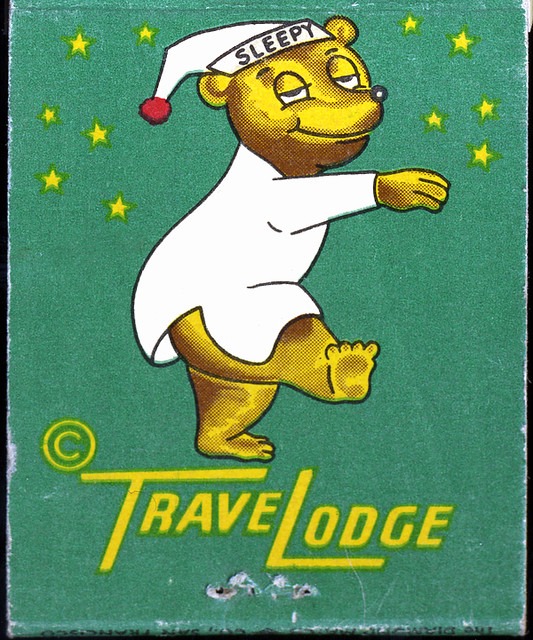
Sleepy Bear had done its job—really well. But as Travelodge expanded and modernized, the classic bear started to feel, well… sleepy in the wrong way. It needed energy. Relevance. A future-forward edge that could capture today’s traveler while honoring decades of loyal guests.
Our Approach: Nostalgia Meets Next-Gen
At Dream Farm Agency, we didn’t bulldoze the bear—we evolved him. We rebuilt his backstory, adding fresh personality traits that aligned with Travelodge’s new mission and values. Sustainability? Check. Adventure? Absolutely. Charm? Always.
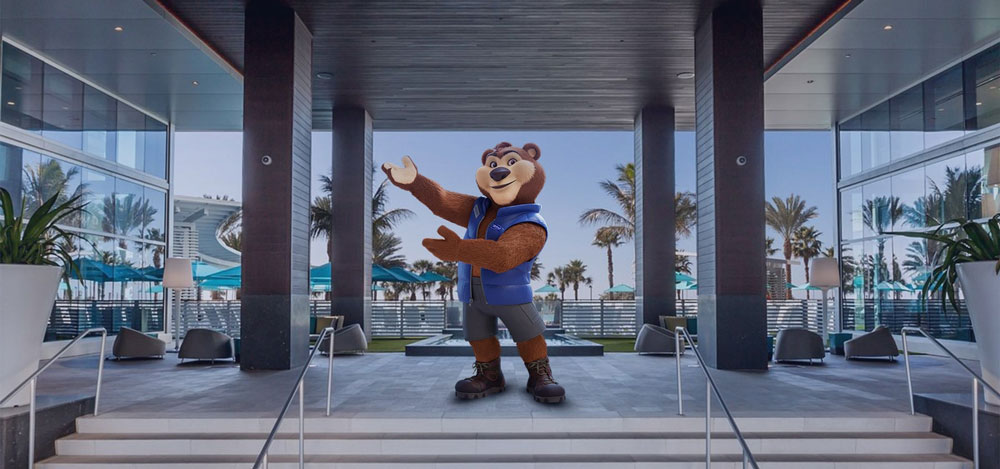
Then came the visuals: we modernized his look, upgraded the detail, and gave Sleepy Bear more expressive features—making him feel lively, healthy, and ready for anything, all without losing the warmth fans already loved.
The Launch: Strategic, Multi-Channel, and Unmissable
The new Sleepy Bear made his grand debut during a Travelodge event tied to their updated marketing strategy. But the reveal didn’t stop there—we extended his presence into:
- Loyalty programs
- Sustainability campaigns
- Ad creative
- Product packaging & merch
- Brand storytelling across touchpoints
And it worked.
The updated mascot didn’t just pass the vibe check—it became the face of Travelodge’s eco-friendly future. Think: energy-efficient messaging, green travel initiatives, and sustainability storytelling—all led by a now-fit, adventure-ready, crowd-approved bear.
TL;DR? Total Win.
Wyndham knew it was time for a change.
We brought their vision to life—strategically, creatively, and with results that speak for themselves.
Final Thoughts: It’s Not Just a Mascot—It’s a Brand Asset
Whether you’re refreshing a legacy character like Sleepy Bear or building a mascot from scratch, one thing’s clear: modern mascots aren’t just decoration. They’re scalable, strategic tools that can engage, represent, and grow with your brand—especially when powered by storytelling, design, and smart tech like AI.
So—if your mascot feels outdated, underused, or flat-out forgotten…
It’s probably time to do what Wyndham did.
Reimagine. Reinvigorate. Relaunch.
And if you’re ready to do it right?
Let’s build your next big character together.
Explore our Virtual Influencer + Mascot Creation Services and let’s start crafting your brand’s most valuable digital face.
Dream Farm Agency Can Help
Updating a brand mascot is a specialized task that requires specialized skills. Understandably, many companies don’t have skilled experts in this field on their teams since it’s often a one-time project, and hiring full-time staff for it isn’t practical.
So, what’s the solution?
It’s best to outsource the job to companies that specialize in brand mascot design and have experience updating characters in line with your brand’s mission and values.
Dream Farm Agency has a proven track record of creating brand mascots and revamping existing characters to meet the evolving needs of audiences.
Reach out to us to discuss your needs—our experts will get started right away.
Updating a brand mascot isn’t a DIY job. It’s a strategic, creative process—and most in-house teams don’t have the time or expertise to do it right.
That’s where we come in.
At Dream Farm Agency, we specialize in creating and modernizing mascots that align with your brand, audience, and future goals. From visual upgrades to full AI-powered makeovers—we’ve done it all.
Ready to give your mascot a powerful refresh? Let’s talk. Our experts are ready to jump in.
Nikan
